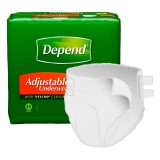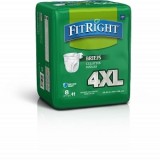Your Cart is Empty

Is all incontinence the same?
What are the causes of incontinence?
Incontinence Statistics
Getting Incontinence Information and Support
Specialists Who Can Treat Incontinence
5 Common Incontinence Myths
Why You Should See a Doctor for Incontinence
Talking To Your Doctor
Incontinence Products Going Mainstream
Home Delivery Products
Incontinence Resources & Links

Is all incontinence the same?
Urinary incontinence, or the inability to control one’s bladder, is a frustrating problem that affects more than 25 million American adults. Incontinence is not a disease, but a symptom of an underlying cause. Your doctor should be the first line of defense in treating the loss of bladder control. Below are the most common types of incontinence:

What are the causes of incontinence?
Before you try out any treatments on your own, it's important to seek professional medical help. Incontinence is a symptom (NOT a disease!) that usually stems from an underlying condition. You could be experiencing bladder leakage due to:

Incontinence Statistics
Learn about the impact and prevalence of incontinence on millions of adults in the United States and worldwide. Statistics are gathered from the National Association for Continence (NAFC).

Getting Incontinence Information and Support
Incontinence can be troubling, confusing, and embarrassing. However, it’s important to understand that you're not alone as incontinence affects more than 25 million adults in the U.S. Incontinence can be a highly emotional issue, so it helps to discuss and share with others who can relate. Online incontinence support groups, such as at Daily Strength and the National Association for Continence (NAFC), offer a community of people who understand your problem first-hand. No matter your gender or the cause or severity of your bladder control problems, there's a community of people out there who understand your problem first-hand. Researching, inquiring, joining, and learning are great ways to help everyone involved understand and manage incontinence.
Knowing where to get incontinence products is also an important part of maintaining good physical and emotional health, as they allow you to assert some degree of control over bladder or bowel issues and help preserve privacy and dignity. National Incontinence has a full line of incontinence supplies designed to accommodate both men and women with varying degrees of incontinence.

Specialists Who Can Treat Incontinence
If you start to experience symptoms of incontinence, it's important to consult your primary care physician. Remember, incontinence is a symptom, not a disease. Depending on the cause of your incontinence, your doctor may refer you to a specialist who's trained to treat the problem. The medical field is very specialized, so all of the different terms and titles can be confusing. Here's a quick guide to terms you might hear during your trip to the doctor's:
When discussing incontinence with any healthcare provider, it's very important to be honest about all of your symptoms in order to receive the most effective advice and treatment. It helps to keep track of your symptoms in a journal right when they appear; that way, when you visit your healthcare provider, he or she will be able to see exactly when the problem started, how and at what rate it got worse or better, etc.

5 Common Incontinence Myths

Why You Should See Your Doctor for Incontinence
Although urinary incontinence is common, bladder leakage is not normal. If you ever experience any bladder problems, such as trouble urinating or leaking urine, it’s important to contact professional help. Since incontinence is a symptom of an underlying cause, you want to rule out any diseases or infections that can cause more significant problems down the road. Incontinence treatment may be as simple as changing your diet, so there should be no reason why you have to suffer in silence and let incontinence stop you from doing what you want to do.
Incontinence can also adversely affect all aspects of your life from work to school to your personal life. You might withdraw from social outings because you feel embarrassed and think that others may ridicule you. You might even give up your favorite activities such as playing soccer or going horseback riding because you’re afraid of having an unexpected leak. Whether it be pelvic floor exercises, bladder retraining, medication, or dietary changes, your doctor can help you find ways to regain bladder control and improve your quality of life.

Talking To Your Doctor
People tend to have difficulties talking about certain things, and discussing bladder control issues might be number one on the taboo topic list for some. If you're experiencing urinary incontinence (UI), it's important to let your healthcare provider know. When discussing the issue with him or her, be prepared to talk openly in order to get the proper diagnosis and most effective treatment. Start by gathering information your healthcare provider may need in order to open the lines of communication.
First, make a list of your incontinence symptoms: difficulty starting to urinate, weak stream, dribbling or leakage, feeling like your bladder isn't emptying completely... the list could go on, but it's very important to include anything and everything you're experiencing. Over a few days, record your urination habits. For example, keep track of how many times you woke up during the night to go to the bathroom, or how many times you felt the urge to urinate and then couldn't. Definitely take note if you've experienced any bleeding or pain while urinating and mention any recent stomach, rib, or back pain. Finally, be honest about whether your urinary symptoms are interfering with your lifestyle.
If you've already started using absorbent undergarments to manage your problem, use them as a sort of gauge. Let your doctor know how much liquid is being captured and how well the absorbency level you're using works. The more information you provide, the better your treatment plan will be.

Incontinence Products Going Mainstream
Incontinence is an embarrassing condition that is often associated with a strong social stigma. That’s why manufacturers are enhancing their incontinence products to make consumers feel more confident in purchasing products to help manage bladder control. Nowadays, people can choose gender-specific products that will cater to the specific needs of their body. Incontinence briefs or underwear now look and feel more like real underwear and come in discreet packaging with transparent windows, just like regular underwear.
Marketing tactics have changed as well. For example, Kimberly-Clark Corporation, which owns popular incontinence brands, such as Depend and Poise, featured actresses and NFL players in its commercials. This showed people that they shouldn't be embarrassed about incontinence, as the condition affects millions of others, including celebrities.
As marketing campaigns work to erase the stigma associated with incontinence, using absorbent products will become more acceptable and less shameful. So if you’re experiencing bladder control problems, keep in mind that, with the wide selection of incontinence products available, you don’t have to suffer in silence.

Home Delivery Products
To maintain a person’s dignity and privacy, opt to shop for incontinence supplies online rather than in stores. Online suppliers also carry a larger selection of protective products than the local grocery or pharmacy stores, so customers can choose from a wide variety of adult diapers, incontinence pads, and mattress protectors for all their needs.
At National Incontinence, we offer an AutoShip plan because we understand the importance of having your products on hand at all times. You can choose to have your favorite incontinence products delivered every month, two months, or whatever interval you want. The AutoShip plan also comes with discounts and savings with each purchase. Most boxes sent to you will be discreetly marked “NI”, while some boxes may indicate the product name. Contact our customer service team at 1-800-998-1745 to find out how you can purchase the products you need while preserving your dignity.

Incontinence Resources & Links
Support Groups and Forums:
Foundations: